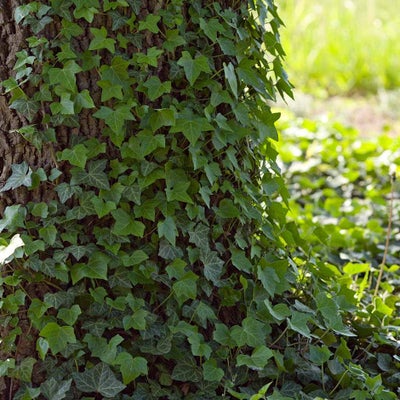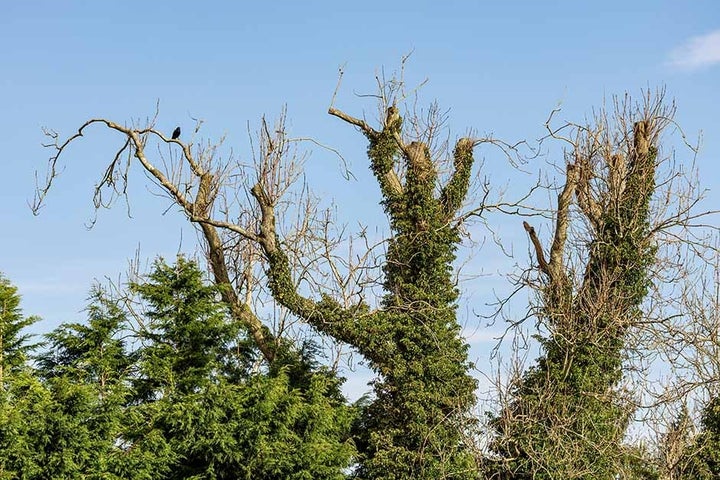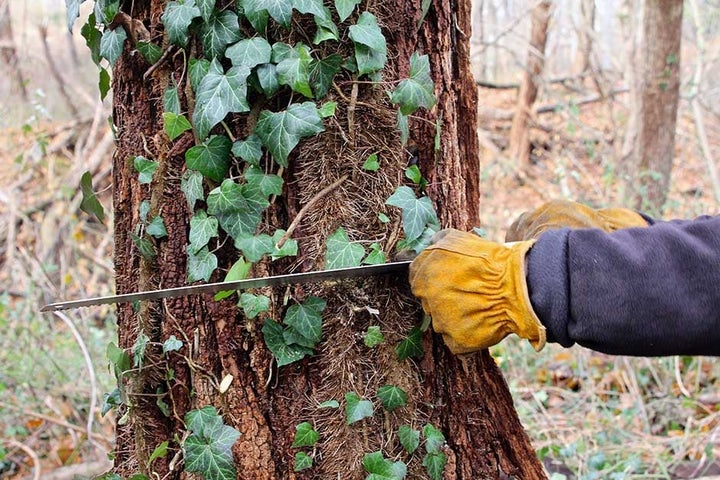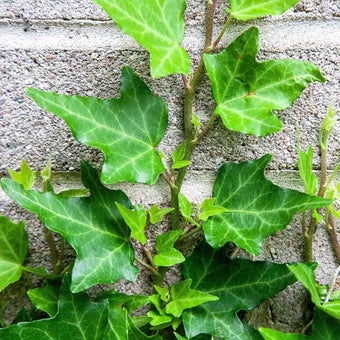
Quick facts
Ivy’s botanical name is Hedera helix; it is also known as common ivy or English ivy
It is native to the UK and found in woodland, hedgerows, scrub and wasteland
Ivy has enormous value to wildlife, providing shelter, nesting places and food for a wide range of insects, mammals and birds
Its vigorous creeping and climbing stems root along their length
If you need to control ivy, non-chemical methods are effective
What does ivy look like?
Ivy is a vigorous, evergreen climber that can grow to 30m (98ft). Its purple-green stems become woody with age and produce (aerial) roots, allowing it to attach to tree trunks or walls, or scramble across the ground.
It has two forms of growth – a juvenile climbing or sprawling stage and a mature, bushy, non-climbing stage. The former has glossy, dark green leaves with 3-5 lobes and pale veins; the latter has heart-shaped leaves and bears clusters of yellow-green flowers in rounded heads from September to November. These are followed by black berries which each contain five seeds. It may take as long as ten years for ivy to become mature and start flowering.

Did you know?
Significant changes in the form and function of plants upon reaching maturity is known as heteroblasty. It is believed to be an adaptation to changes in light level within a forest canopy, with juvenile growth better adapted to cope with shady conditions on the forest floor, and mature growth able to capitalise on direct sunlight among the tree tops.
Is ivy a weed?
Ivy has enormous value to wildlife:
- Its dense, evergreen leaves provide year-round hiding, roosting and hibernating places for various insects, birds and small mammals
- It is a preferred nesting plant for dunnocks, flycatchers, wrens and robins
- Its leaves are an important food source for caterpillars of many butterflies and moths, including the holly blue butterfly and swallow-tailed moth
- Its flowers are an invaluable late pollen and nectar source for many pollinating insects, including bees, hoverflies, wasps, butterflies and moths
- Its high-fat berries are eaten by numerous different garden birds, including blackbirds, finches, thrushes, doves, starlings, waxwings and pigeons
- As a groundcover plant, it can greatly lessen the effect of frost, allowing creatures to forage in its leaf litter during cold weather
Did you know?
The ivy mining bee (Colletes hederae) forages almost exclusively on the pollen and nectar of ivy flowers. It is a relatively new arrival to the UK, first recorded here in 2001, and is now widespread across Southern England and Wales.

Ivy is also a useful garden plant, able to cover a large area and tolerate deep shade. There are many cultivars available with a variety of leaf colours and patterns, making it an attractive choice for evergreen groundcover. For information on selecting, pruning and training ivy, see our growing guide on Hedera (ivy).
However, ivy is a fast-growing, vigorous plant. It is often seen as a weed as it can quickly smother smaller plants and colonise areas of bare soil. In trees, it can obscure attractive , hide and exacerbate existing problems and even overwhelm and outcompete thin-canopied species.
What is a weed?
The term ‘weed’ describes a plant that is growing where it isn’t wanted. Weeds usually thrive in average garden conditions, reproducing and spreading easily. It is up to you to decide what you call a weed and what you choose to retain or remove.
Frequently asked questions about controlling ivy
Here are our answers to your most common questions about controlling ivy:
How invasive is ivy?
Ivy spreads primarily by its fast-growing stems which root along their length. A single ivy plant can easily cover several metres of bare ground, growing between other plants and potentially smothering smaller ones. Its stems readily grow through and along hedges, as well as over fences, so ivy may be introduced to a garden from neighbouring land. It is, however, relatively easy to keep ground-covering growth in check, by pruning back stems and digging-up rooted sections.
Climbing ivy also produces seed once it matures, though it may take ten years or more to reach this point. As the berries are eaten by birds, seed may be deposited a long way from the parent plant, and it is unusual to see lots of ivy appearing in a garden. Any that do can be easily removed before they become established.
Is ivy harmful to trees?
Although ivy on trees is often thought to be a serious problem, endangering the health of even large trees, it isn’t directly harmful. Its aerial roots don’t penetrate tree – they attach to it for support only – and mature, healthy trees are able to cope with some competition at ground level for water and nutrients, and at canopy level for light.
There are, however, a few instances where it might be desirable or necessary to remove ivy from tree trunks:
- On ornamental trees with decorative bark, like many birches and acers, which can become obscured by ivy
- On young or newly planted trees which can suffer from competition for light, water and nutrients
- On trees with sparse canopies, like ash (Fraxinus) and larch (Larix), which can become heavily smothered and weakened from competition
- On old, weak or previously damaged trees, where ivy growth can hide problems such as cavities or signs of decay, potentially making a tree unsafe. The extra weight of ivy on an already ailing tree can also make the canopy unstable, particularly in windy conditions.
Good to know
Ivy often grows into the canopy of trees that are already in decline. If you are concerned about an old, ailing tree, seek advice about its health and safety from a tree consultant.

Do I need to get rid of ivy?
No – allowing ivy to grow in a wildlife area, woodland, less-cultivated area or along and among a mature hedge is a great way to attract wildlife and boost the of your garden. Ivy is a valuable garden plant as it tolerates challenging conditions, such as deep shade and dry soil, where many other plants would struggle to grow.


It is, however, a good idea to control the spread of ivy to stop it creeping out of bounds.
What is the easiest way to kill ivy?
As ivy is so beneficial to wildlife and is not directly harmful to trees, it is preferable to control its spread, rather than remove it completely. However, if you have ivy growing where it is not wanted, or removal is necessary due to a tree safety concern, there are the following options:
On trees
- Cut across all stems near to ground level – using loppers, a pruning saw or a chainsaw if very woody. Severing the stems kills what is already growing up a tree, although dead brown leaves often remain attached. On large trees it is not usually possible to detach the stems, and leaving these in place allows them to continue to provide shelter for wildlife.
- Dig out the woody stump – using a sharp spade (and pickaxe if necessary). This will prevent ivy from regrowing but is often not possible due to the stump's proximity to the tree trunk. If you can’t remove the stump, regularly cut any new growth back to ground level. This will weaken the plant, although it may take a long time to completely kill it.
Top Tip
Check for nesting birds before you do any work to control or remove ivy. It is an offence under the Wildlife & Countryside Act 1981 to damage or destroy the nest of any wild bird while it is in use or being built. Nesting season generally lasts from March to August, but it may last longer for certain birds or those with multiple broods, so always check before starting.

As groundcover
- Prune stems regularly during the growing season – to keep them within a defined area and prevent them rooting. Use secateurs, shears or a hedge trimmer depending on the size of the area.
- Pull and dig up stems and roots – work across an area of ivy hand-pulling and forking out any rooted sections of stem. Secateurs and loppers are useful to cut through crossing stems and make inroads. Use a border fork, inserted to its full depth, to dig out any well-rooted sections. Keep a close eye on the cleared area, removing any regrowth promptly.
- Smother plants – a good option where vegetation is very dense and digging up ivy isn’t practical. Use a strimmer to remove all top growth before covering the ground with a layer of compostable material, such as cardboard, and then a layer about 20cm (8in) thick of organic matter, such as bark or wood chips. Alternatively, use a heavy duty matting. This will block light and prevent growth, causing the root system to die. Keep soil covered for a few years, topping up the mulch layer if necessary, to ensure this method is effective.
All parts of ivy except very woody stems/roots can be added to your home compost or green waste recycling bin.
Take care
Contact with ivy can irritate your skin, so wear gloves and cover arms/legs when handling or working amongst it. It is also harmful if eaten, for humans and pets, so take care not to feed it to your pets and ensure children and pets don’t play in areas where it grows.
Should I use weedkiller?
No – although it can take time and patience to completely remove ivy, non-chemical methods are effective, so there is no need to use a weedkiller.
As ivy has glossy, moisture-resistant leaves, weedkiller sprays are often ineffective, and it may take several applications to see any marked effect.

















